- News
- Reviews
- Bikes
- Accessories
- Accessories - misc
- Computer mounts
- Bags
- Bar ends
- Bike bags & cases
- Bottle cages
- Bottles
- Cameras
- Car racks
- Child seats
- Computers
- Glasses
- GPS units
- Helmets
- Lights - front
- Lights - rear
- Lights - sets
- Locks
- Mirrors
- Mudguards
- Racks
- Pumps & CO2 inflators
- Puncture kits
- Reflectives
- Smart watches
- Stands and racks
- Trailers
- Clothing
- Components
- Bar tape & grips
- Bottom brackets
- Brake & gear cables
- Brake & STI levers
- Brake pads & spares
- Brakes
- Cassettes & freewheels
- Chains
- Chainsets & chainrings
- Derailleurs - front
- Derailleurs - rear
- Forks
- Gear levers & shifters
- Groupsets
- Handlebars & extensions
- Headsets
- Hubs
- Inner tubes
- Pedals
- Quick releases & skewers
- Saddles
- Seatposts
- Stems
- Wheels
- Tyres
- Health, fitness and nutrition
- Tools and workshop
- Miscellaneous
- Cross country mountain bikes
- Tubeless valves
- Buyers Guides
- Features
- Forum
- Recommends
- Podcast
review
£3,999.00
VERDICT:
Scott's Foil aero bike is impressively fast but its stiff ride won't suit everyone.
Weight:
7,520g
Contact:
www.scott-sports.com
At road.cc every product is thoroughly tested for as long as it takes to get a proper insight into how well it works. Our reviewers are experienced cyclists that we trust to be objective. While we strive to ensure that opinions expressed are backed up by facts, reviews are by their nature an informed opinion, not a definitive verdict. We don't intentionally try to break anything (except locks) but we do try to look for weak points in any design. The overall score is not just an average of the other scores: it reflects both a product's function and value – with value determined by how a product compares with items of similar spec, quality, and price.
What the road.cc scores meanGood scores are more common than bad, because fortunately good products are more common than bad.
- Exceptional
- Excellent
- Very Good
- Good
- Quite good
- Average
- Not so good
- Poor
- Bad
- Appalling
Light and direct aero bike with fast handling but uncompromising stiffness.
The aero road bike market is hotting up. Scott were in the vanguard, as one first big manufacturers to go down the route of combining aerodynamic features into a road bike with the release of their Foil back in 2011.
With the lightweight Addict absent for several years, the Foil has been the mainstay of Scott's road bike range with eight models available covering a range of prices. We've been testing the £3,999 model equipped with an electronic Shimano Ultegra Di2 groupset, Syncros finishing kit and wheels, and a sleek grey paintjob.
Frame: Aero inspired frame and fork
The Foil was the result of Scott working with renowned aerodynamicist Simon Smart, whose background in F1 aerodynamics made him a natural choice to help them with their first ever aero road bike. Reducing drag is the aim of the Foil, but if you take a close look at the frame, it doesn't have the long sleek airfoil shaped tubes and cutaway seat tube of most aero road bikes.
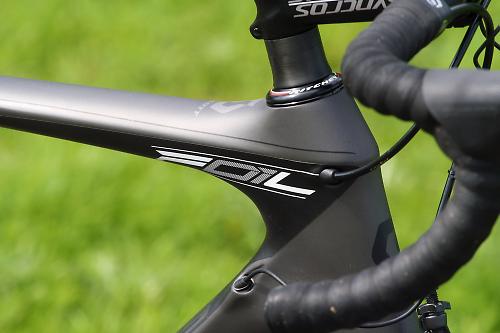
When Scott set out to design the Foil, aerodynamics wasn't the only objective. Stiffness, and maximising it, was also an essential part of the design. That shows in the profile of the tubes they've used, which follow similar lines to the Kamm Tail profile the likes of Trek have used in their latest Madone. These are airfoil tubes with a truncated tail, which tricks the air into acting as if the trail wasn't truncated. Thats allowed Scott to use tube profiles that would deliver on the weight and stiffness front.
The downtube, fork blades, seat tube and seat stays, the main parts of the frame facing the wind, are shaped in this manner. Scott have considered how the air behaves as it passes over the frame from front to back, and as a result the seat stays are carefully angled at four degrees from the seat tube to reduce drag.
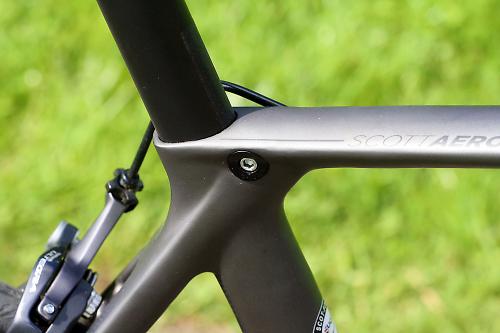
The frame is made from Scott's HMF NET Carbon. NET stands for Naked External Tubeset, which means the frame goes without a cosmetic outer layer of carbon to shed the weight. Further weight is saved on the frame with carbon dropouts, carbon bearing faces in the bottom bracket and head tube, producing a claimed frame weight of about 850g.
The other, increasingly standard design feature these days, is the internal routing of the cables. This test bike came equipped with an electronic groupset, and uses special plugs that slot into the moulded cable entry ports. The redundant port at the top of the downtube on the non-driveside is an unfortunate reminder of the bike's provision for mechanical groupsets.
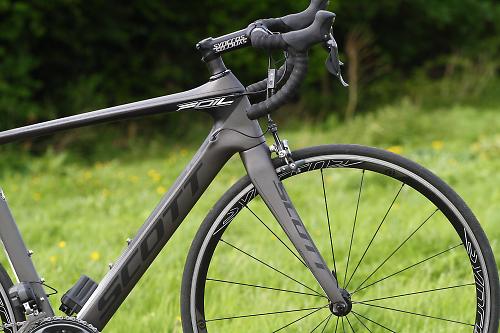
Geometry is suitable racey; a 16cm head tube on this 56cm test bike places the bars reasonably low. A 73 degree head tube angle and 73.3 degree seat angle is fairly standard stuff and provides predictable handling. Scott alter the seat tube angle across the size range to suit different height people. If you want stack and reach, the figures are 569mm and 394mm respectively.
Build kit: Solid and dependable but not light
A Shimano Ultegra 6770 Di2 groupset plugs into the frame. We're fans of the Ultegra groupset, it offers near identical performance to Dura-Ace but costs a lot less money, and the only handicap is the slightly higher weight. If you're moving from mechanical Shimano to Di2 for the first time, allow some time to get used to the shifter. The buttons have a very different feel and it does take a few hours in the saddle to get comfortable with it. Once you are though, shifting is fast, precise and crisp.

Showing the Foil's racing potential is a 53/39 double chainset, partnered with a 11-25t cassette. Make no mistake, this bike is clearly set up for blasting along fast roads at maximum speed, elbows tucked around your knees in the drops and keeping the speed high. It looks fast and certainly wants to ride fast.
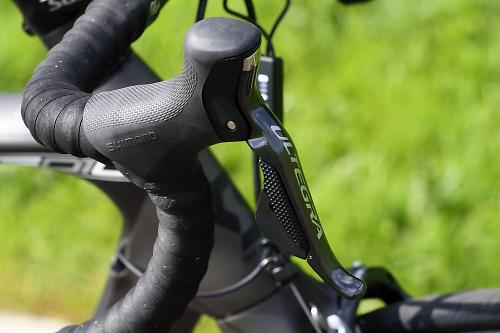
The build kit is solid stuff for the money. It all wears the logo of Scott's Syncros component arm. The Syncros components are high quality parts: an aluminium stem with a four-bolt faceplate and a nicely shaped aluminium handlebar. I had to change the 11cm stem for a 12cm stem to get my desired reach. There are ample spacers on the steerer tube to allow you to tailor the height of the front, so there's scope to trim the steerer tube down once you've dialled your position and fit.
The carbon aero seatpost, unique to the Foil, wears the Ritchey label. It's manufactured by Ritchey to Scott's design and has a simple one-bolt clamp up top. The saddle is a Syncros item that has a very flat shape with a little recess along the middle. It's not an uncomfortable perch by any means, but is on the firm side.
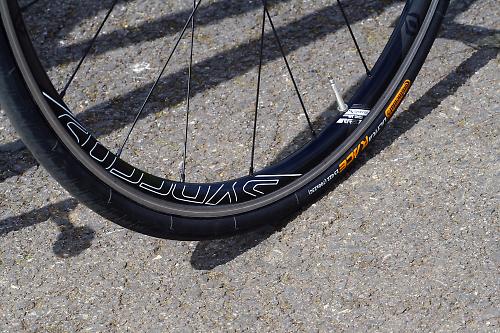
Syncros supply the RR 2.0 wheelset, shod with Continental Ultra Race 23mm clincher tyres. They're not the lightest wheels at 1,720g for the pair, but do offer a slight aero performance gain with the 30mm semi-deep rim. The hubs are Scott's own CNC-machined items packed with DT Swiss internals, and laced to the rims with DT Swiss spokes, 20 radial in the front wheel and 24 in the rear wheel, radial and two-cross. They're a reasonably swift set of wheels when the momentum is on your side, but you can feel their weight on the steeper pitched climbs.
The complete weight for the Foil 15 is a competitive 7.52kg (16.57lb), giving you a fighting chance on the climbs. There's weight to be lost in a wheel upgrade down the line as well, and it wouldn't take much effort to get close to 7kg. But worrying about weight with the Foil is kind of missing the point of the bike, for there are more obvious choices if you're a weight weenie climber and want the lightest bike at this price. The Foil offers the aero performance with little discernable weight penalty.
Ride: Stiff all of the time
To describe the ride of the Foil in one word, I would plump for stiff. It's the first word on my lips at the beginning of a ride, and the last word on my lips when I returned home. The stiffness, in combination with the quick shifting Ultegra Di2 and fast wheels, makes for a compellingly fast bike. If speed and going fast is your main criteria when choosing a bike, the Foil needs to be on your shortlist.
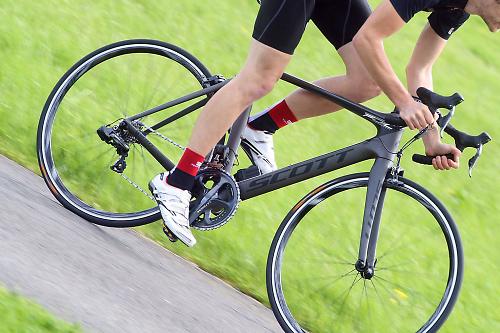
On rides when you want to exploit its speed, and gain maximum acceleration through the bends and crest rises with ferocity, the Foil absolutely delivers. If you just want to ride fast, and fast all of the time, the Foil perfectly, brilliantly, exceptionally delivers.
But there's no off switch, it's all of nothing with the Foil. The fact the Foil was designed to offer excellent stiffness as well as aerodynamics shows clearly in the ride manners.
An upshot of the stiff tracking frame is how it responds to steering inputs. It's very direct and communicates clearly to you the condition of the road surface, and how much grip is available. On the descents, while not the fastest bike I've ridden, it tracks smartly and with great accuracy. It's also predictable and doesn't throw up any surprises in the handling department.
It's all kind of addictive if you crave going as fast as possible. As for the aero benefits of the frame, without our own wind-tunnel to test it, we have to go on seat of the bib shorts feel, and in this limited test it certainly delivers. Looking at some of my ride times on roads I've ridden a thousand times on many test bikes, the Foil shows a clear, but marginal, increase in average speeds.
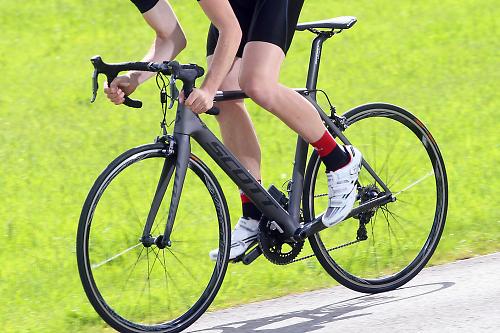
But it is uncompromisingly stiff. It's stiff all of the time. When you want to settle down for a comfortable cruise through the lanes, the Foil bumps, jolts and jars over even the smallest imperfection in the Tarmac. Hit a crack or hole in the road and you'd better have a good grip on the handlebars. It's alarming at first, though you do become accustomed to it. But the feeling that it's just too stiff never leaves you.
If you like your bikes stiff, or you live somewhere where the roads are pimple free, if you're looking for a brutally quick and fast handling race bike, the Foil is hard to beat. But while the Foil may be faster in a wind tunnel, in real-world riding situations it's very hard to justify, and I feel that most people will be better served by something else.
Verdict
Scott's Foil aero bike is impressively fast but its stiff ride won't suit everyone.
road.cc test report
Make and model: Scott Foil 15
Size tested: 56cm
About the bike
State the frame and fork material and method of construction. List the components used to build up the bike.
The Foil 15 is an Aero Road bike, developed to be faster and more efficient in all ROAD conditions. This aero HMF carbon fiber bike brings Shimano's Ultegra Di2 electronic shifting to the people. Ride the future, without the premium price.
Tell us what the bike is for, and who it's aimed at. What do the manufacturers say about it? How does that compare to your own feelings about the bike?
Frame: SCOTT FOIL HMF NET Carbon
Fork: Scott FOIL HMF NET Carbon steerer
Group set: Shimano Ultegra Eletronic Shift System
Brakes: Shimano Ultegra
Parts: Syncros 1.5 Series
Wheels: Syncros RR 2.0
While we already use the proven HMF composite fiber on all our composite high-end bike models, we have improved upon conventional HMF material. This new fiber, which is produced exclusively for SCOTT, offers 20% more stiffness and is employed on all the areas that need additional rigidity. This new material also allows us to reduce weight and improve riding characteristics. NET stands for Naked External Tubeset, where the frame sheds its exterior cosmetic layer, which saves even more weight.
Frame and fork
Overall rating for frame and fork
8/10
Tell us about the build quality and finish of the frame and fork?
Excellent build quality and attention to detail
Tell us about the materials used in the frame and fork?
HMF NET Carbon with no cosmetic layer and carbon dropouts and bearing faces in the head tube
Tell us about the geometry of the frame and fork?
Reasonably aggressive with a shortish head tube that is in line with the Foil's race intentions
How was the bike in terms of height and reach? How did it compare to other bikes of the same stated size?
With a change of stem length it fitted just fine
Riding the bike
Was the bike comfortable to ride? Tell us how you felt about the ride quality.
No it wasn't, it's one of the stiffest bikes I've tested. Comfort is severely compromised
Did the bike feel stiff in the right places? Did any part of the bike feel too stiff or too flexible?
Very stiff in the right places, around the bottom bracket and chainstays with no noticeable deflection when stamping hard on the pedals
How did the bike transfer power? Did it feel efficient?
Very efficient at transferring power
Was there any toe-clip overlap with the front wheel? If so, was it a problem?
No
How would you describe the steering? Was it lively, neutral or unresponsive? Confident
Tell us some more about the handling. How did the bike feel overall? Did it do particular things well or badly?
Handling of the Foil is fantastic, helped by the very stiff frame and fork package
Which components had the most effect (good or bad) on the bike's comfort? would you recommend any changes?
Aluminium handlebars and stem will be stiffer than their carbon counterparts
Which components had the most effect (good or bad) on the bike's stiffness? would you recommend any changes?
As above
Which components had the most effect (good or bad) on the bike's efficiency? would you recommend any changes?
Lighter wheels would help on the climbs
Rate the bike for efficiency of power transfer:
9/10
Rate the bike for acceleration:
9/10
Rate the bike for sprinting:
9/10
Rate the bike for high speed stability:
8/10
Rate the bike for cruising speed stability:
7/10
Rate the bike for low speed stability:
7/10
Rate the bike for flat cornering:
8/10
Rate the bike for cornering on descents:
8/10
Rate the bike for climbing:
6/10
The drivetrain
Rate the drivetrain for performance:
9/10
Rate the drivetrain for durability:
8/10
Rate the drivetrain for weight:
6/10
Rate the drivetrain for value:
7/10
Tell us some more about the drivetrain. Anything you particularly did or didn't like? Any components which didn't work well together?
The Ultegra Di2 groupset offer flawless shifting
Wheels and tyres
Rate the wheels and tyres for performance:
8/10
Rate the wheels and tyres for durability:
8/10
Rate the wheels and tyres for weight:
7/10
Rate the wheels and tyres for comfort:
7/10
Rate the wheels and tyres for value:
7/10
Tell us some more about the wheels and tyres.Did they work well in the conditions you encountered? Would you change the wheels or tyres? If so, what for?
The wheel and tyre package is well suited to the bike, the semi-deep 30mm wheels are fast but not the lightest or most comfortable
Controls
Rate the controls for performance:
8/10
Rate the controls for durability:
8/10
Rate the controls for weight:
7/10
Rate the controls for comfort:
7/10
Rate the controls for value:
8/10
Tell us some more about the controls. Any particularly good or bad components? How would the controls work for larger or smaller riders?
Nicely shaped handlebars but the stem was too short for me
Anything else you want to say about the componentry? Comment on any other components (good or bad)
The aero seatpost makes setting the saddle up a doddle
Your summary
Did you enjoy riding the bike? Yes, on smooth roads and in races
Would you consider buying the bike? Not sure
Would you recommend the bike to a friend? Possibly
Rate the bike overall for performance:
7/10
Rate the bike overall for value:
7/10
Anything further to say about the bike in conclusion?
A fantastic bike but high stiffness level won't suit everyone
About the tester
Age: 31 Height: 180 Weight: 67
I usually ride: My best bike is:
I've been riding for: 10-20 years I ride: Every day I would class myself as: Expert
I regularly do the following types of riding: road racing, time trialling, cyclo cross, commuting, touring, mtb,
David worked on the road.cc tech team from 2012-2020. Previously he was editor of Bikemagic.com and before that staff writer at RCUK. He's a seasoned cyclist of all disciplines, from road to mountain biking, touring to cyclo-cross, he only wishes he had time to ride them all. He's mildly competitive, though he'll never admit it, and is a frequent road racer but is too lazy to do really well. He currently resides in the Cotswolds, and you can now find him over on his own YouTube channel David Arthur - Just Ride Bikes.
Latest Comments
- Steve K 1 sec ago
Sorry, but Rendel is right. Please don't use such offensive terms. As you say, it's not 1980, when maybe we were a little less aware of prejudice...
- andystow 6 hours 29 min ago
I've been using Power Grips for over five years now. They're great.
- David9694 7 hours 19 min ago
Drivers ignored road closures at Colchester Half Marathon...
- David9694 7 hours 38 min ago
driverless, car-less......
- dh700 7 hours 41 min ago
I already mentioned the strategies that work, which are reductions of motor vehicle usage and lawlessness. For example, Sweden's population has...
- Surreyrider 9 hours 37 min ago
A lengthy reply that doesn't match the reality. I'm still never going to buy your wheels after the posts from a fellow Outcasts Cycling member in...
- eburtthebike 10 hours 55 min ago
It wouldn't matter if it was made last week in China out of plastic: it's still a good enough reason to deny cyclists safer roads.
- Smoggysteve 15 hours 27 min ago
That's a possibility. But if that were the case, it wouldn't explain how I still get it on Zwift where Garmin wasn't even in play. The power from...
- bikeman01 16 hours 4 min ago
They should bring back dog tax, sorry dog licences. That would fix everything, [sic].
- BikingBud 16 hours 56 min ago
Aren't 4*4 supposed to go off road?




































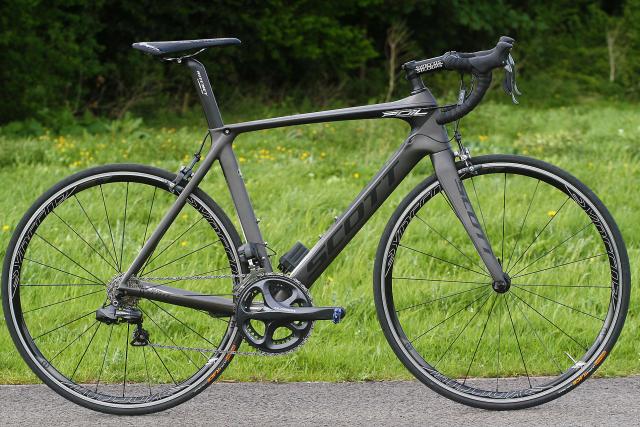




Add new comment
4 comments
Hear that, David Arthur? You've been voted 'half decent'. Go on, give yourself a celebratory hug.
Fine, at least they got a half decent reviewer of this bike.
its stiff is it?
kinda need one of these in my life